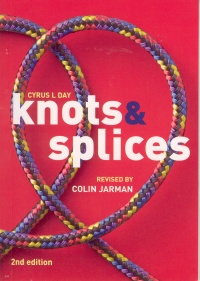| ________________
CM . . .
. Volume XIII Number 11 . . . .January 19, 2007 
 |
Knots & Splices. 2nd. ed.
Cyrus L. Day. Revised by Colin Jarman. Photographs by Colin Jarman.
Halifax, NS: Nimbus, 2006.
64 pp., pbk., $8.95.
ISBN 1-55109-574-2.
Subject Heading:
Knots and splices.
Grades 7 and up.
Review by Dave Jenkinson.
*** /4
|
| |
|

excerpt:
FOREWORD TO THE 2ND EDITION
Knots & Splices has been in print for over 50 years, which must stand as quite a record for a book of this type. A copy was given to me as a Christmas present around 1957 and it sparked an interest in knots and rope work that has lasted to this day. The knots and splices I learned from Cyrus Day have stood me in good stead over a lifetime of boating, and it was with huge excitement that I took on the project of updating this book for the 21st century. I hope that he would have approved of what I've done to his book; I hope that it will inspire others as his did me and that it will continue in print for another 50 years!
Using this brief handbook, children, youth and adults can learn how to tie 78 "knots." After an opening three page glossary which introduces "knotting" vocabulary that will be used throughout the book, Jarman divides the book's practical contents into a dozen sections: Basic knots; Bends; Loops; Hitches and similar knots; Belaying or cleating; Whipping; Seizing; End or stopper knots; Turk's Head; To weight a heaving line; A selection of useful knots; and Splicing. Sections differ in their scope so that "Bends" contains 11 knots while "Turk's Head" is limited to that single, largely decorative knot. Because knots played such an important role in the days of wind powered oceangoing vessels, many of the book's knots were originally developed in response to the needs of sail, and these remain quite useful today to those involved in recreational boating; however, a lot of the book's contents have land-based applications as well.
How-to-tie illustrations in the form of full-colour photographs, accompanied by step-by-step text, lead the reader through achieving each knot. The brief text also indicates a knot's uses, and, where appropriate, any safety concerns. For example, the text of the "Overhand Loop" contains the following advice:
The Overhand Loop is very unlikely to shake loose and become untied, but the Bowline, which is structurally a better knot, can, particularly when formed in rope made of slippery material. When there is danger of it doing so, the end of a Bowline should always be stopped to the standing part or secured with an Overhand Knot or Half Hitch.
When a knot involves more than one rope, the two ropes are of different colours with the contrasting colours making it easier to follow how the knot is being formed. Perhaps it's just my older eyes, but I did find the photographs relating to "Whipping" and especially "Splicing" somewhat too small to be able to easily follow the steps being illustrated.
As a longtime knotter, myself,through my decades long connection with Scouting, I found that I was still learning some things from Knots & Splices that I had not encountered before, even some points relating to quite simple knots. For example, I've used the Sheet Bend on countless occasions to join two ropes of unequal thickness, but I never knew that if I ended up with the ends of the two ropes I had joined being on opposite sides, then what I had really tied was a Left-Handed Sheet Bend, and I needed to be concerned because this knot could "slip," a dangerous happening in certain circumstances.
Unlike some of the other knotting books on the market, the slim Knots & Splices, just 15 by 10.5 cms. in size, will fit easily into the pocket of a jacket or backpack. The book's portability is a great advantage, especially in those initial instances when one is called upon to apply a not-completely-learned new knot in the field.
While more likely to be found in the adult section of public libraries and possibly passed over in school libraries because its contents don't have an obvious curriculum connection, other than outdoor education, Knots & Splices would be of interest to children and youth involved in programs that incorporate hiking, camping, climbing, sailing or canoeing.
Recommended.
Dave Jenkinson teaches courses in adolescent literature at the Faculty of Education, the University of Manitoba..

To comment
on this title or this review, send mail to cm@umanitoba.ca.
Copyright © the Manitoba Library Association. Reproduction for personal
use is permitted only if this copyright notice is maintained. Any
other reproduction is prohibited without permission.
NEXT REVIEW |
TABLE OF CONTENTS FOR THIS ISSUE
- January 19, 2007.
AUTHORS |
TITLES |
MEDIA REVIEWS |
PROFILES |
BACK ISSUES |
SEARCH |
CMARCHIVE |
HOME |
